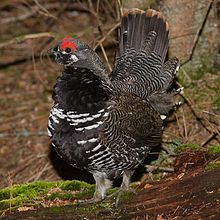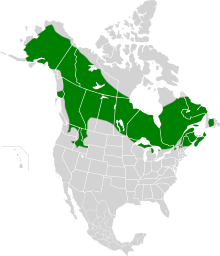Spruce grouse
| Spruce grouse | |
|---|---|
 |
|
| Male of the nominate subspecies | |
 |
|
| Female | |
| Scientific classification | |
| Kingdom: | Animalia |
| Phylum: | Chordata |
| Class: | Aves |
| Order: | Galliformes |
| Family: | Phasianidae |
| Subfamily: | Tetraoninae |
| Genus: | Falcipennis |
| Species: | F. canadensis |
| Binomial name | |
|
Falcipennis canadensis (Linnaeus, 1758) |
|
| Subspecies | |
 |
|
| Distribution map of the spruce grouse | |
| Synonyms | |
|
|
The spruce grouse or Canada grouse (Falcipennis canadensis) is a medium-sized grouse closely associated with the coniferous boreal forests or taiga of North America. It is one of the most arboreal grouse, fairly well adapted to perching and moving about in trees. When approached by a predator, it relies on camouflage and immobility to an amazing degree, for example letting people come to within a few feet before finally taking flight, a behavior that has earned it the nickname "fool's hen".
Spruce grouse are 38–43 cm (15–17 in) long; males weigh 550–650 g (19–23 oz) and females 450–550 g (16–19 oz). Races vary slightly in plumage, especially in the tail pattern and in the extent of white on the underparts, but in general adult males are mainly grey above and black below, with white spots along the side, and a red patch of bare skin over the eye. Adult females are mottled brown (red morph) or mottled grey (grey morph) with dark and white bars on the underparts. Juveniles resemble females. Females may be confused with ruffed grouse but they have a dark tail with a pale band at the end (while the reverse is true in ruffed grouse) and they do not erect their crown feathers when alarmed the way ruffed grouse do.
In the first half of the century, spruce grouse were classified as two separate species in the genus Canachites: spruce grouse (C. canadensis) and Franklin's grouse (C. franklinii), a position reinstated by Birdlife International in 2014. Then the species were unified and moved to the genus Dendragapus, congeneric with the blue grouse with which spruce grouse often share coniferous habitats. However, spruce grouse do not have inflatable cervical sacs as in blue grouse, and the natal plumage of the two species is different. Based on its stronger resemblance to the Siberian grouse (Falcipennis falcipennis), the spruce grouse is now recognized as belonging to the genus Falcipennis. Currently five subspecies are recognized:
Franklin's grouse (F. franklinii) of British Columbia and the Rocky Mountains was recently split as a distinct species from canadensis and also consists of the subspecies isleibi in Prince of Wales Island and nearby Alexander Archipelago in southeast Alaska.
...
Wikipedia

